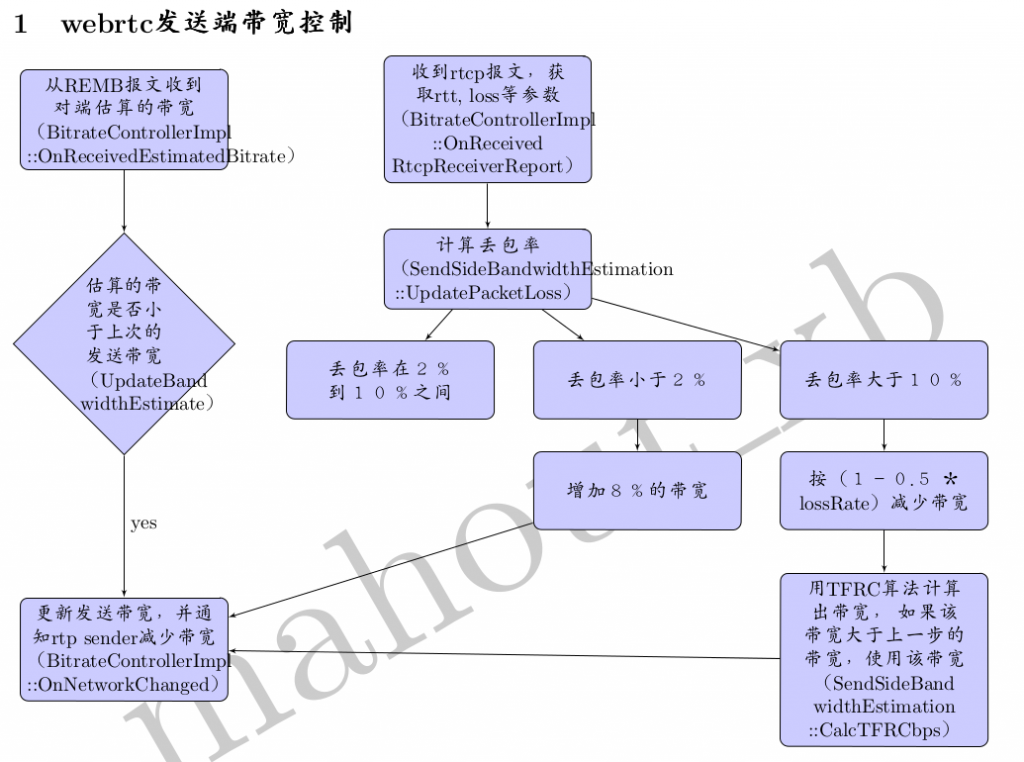webrtc中的带宽自适应算法分为两种:
1, 发端带宽控制, 原理是由rtcp中的丢包统计来动态的增加或减少带宽,在减少带宽时使用TFRC算法来增加平滑度。
2, 收端带宽估算, 原理是并由收到rtp数据,估出带宽; 用卡尔曼滤波,对每一帧的发送时间和接收时间进行分析, 从而得出网络带宽利用情况,修正估出的带宽。
两种算法相辅相成, 收端将估算的带宽发送给发端, 发端结合收到的带宽以及丢包率,调整发送的带宽。
下面具体分析两种算法:

2, 接收端带宽估算算法分析
结合文档http://tools.ietf.org/html/draft-alvestrand-rtcweb-congestion-02以及源码webrtc/modules/remote_bitrate_estimator/overuse_detector.cc进行分析
带宽估算模型: d(i) = dL(i) / c + w(i) d(i)两帧数据的网络传输时间差,dL(i)两帧数据的大小差, c为网络传输能力, w(i)是我们关注的重点, 它主要由三个因素决定:发送速率, 网络路由能力, 以及网络传输能力。w(i)符合高斯分布, 有如下结论:当w(i)增加是,占用过多带宽(over-using);当w(i)减少时,占用较少带宽(under-using);为0时,用到恰好的带宽。所以,只要我们能计算出w(i),即能判断目前的网络使用情况,从而增加或减少发送的速率。
算法原理:即应用kalman-filters
theta_hat(i) = [1/C_hat(i) m_hat(i)]^T // i时间点的状态由C, m共同表示,theta_hat(i)即此时的估算值
z(i) = d(i) - h_bar(i)^T * theta_hat(i-1) //d(i)为测试值,可以很容易计算出, 后面的可以认为是d(i-1)的估算值, 因此z(i)就是d(i)的偏差,即residual
theta_hat(i) = theta_hat(i-1) + z(i) * k_bar(i) //好了,这个就是我们要的结果,关键是k值的选取,下面两个公式即是取k值的,具体推导见后继博文。
E(i-1) * h_bar(i)
k_bar(i) = --------------------------------------------
var_v_hat + h_bar(i)^T * E(i-1) * h_bar(i)
E(i) = (I - K_bar(i) * h_bar(i)^T) * E(i-1) + Q(i) // h_bar(i)由帧的数据包大小算出
由此可见,我们只需要知道当前帧的长度,发送时间,接收时间以及前一帧的状态,就可以计算出网络使用情况。
接下来具体看一下代码:
- void OveruseDetector::UpdateKalman(int64_t t_delta,
- double ts_delta,
- uint32_t frame_size,
- uint32_t prev_frame_size) {
- const double min_frame_period = UpdateMinFramePeriod(ts_delta);
- const double drift = CurrentDrift();
-
- const double t_ts_delta = t_delta - ts_delta / drift;
- double fs_delta = static_cast<double>(frame_size) - prev_frame_size;
-
-
- const double scale_factor = min_frame_period / (1000.0 / 30.0);
- E_[0][0] += process_noise_[0] * scale_factor;
- E_[1][1] += process_noise_[1] * scale_factor;
-
- if ((hypothesis_ == kBwOverusing && offset_ < prev_offset_) ||
- (hypothesis_ == kBwUnderusing && offset_ > prev_offset_)) {
- E_[1][1] += 10 * process_noise_[1] * scale_factor;
- }
-
- const double h[2] = {fs_delta, 1.0};
- const double Eh[2] = {E_[0][0]*h[0] + E_[0][1]*h[1],
- E_[1][0]*h[0] + E_[1][1]*h[1]};
-
- const double residual = t_ts_delta - slope_*h[0] - offset_;
-
- const bool stable_state =
- (BWE_MIN(num_of_deltas_, 60) * fabsf(offset_) < threshold_);
-
-
- if (fabsf(residual) < 3 * sqrt(var_noise_)) {
- UpdateNoiseEstimate(residual, min_frame_period, stable_state);
- } else {
- UpdateNoiseEstimate(3 * sqrt(var_noise_), min_frame_period, stable_state);
- }
-
- const double denom = var_noise_ + h[0]*Eh[0] + h[1]*Eh[1];
-
- const double K[2] = {Eh[0] / denom,
- Eh[1] / denom};
-
- const double IKh[2][2] = {{1.0 - K[0]*h[0], -K[0]*h[1]},
- {-K[1]*h[0], 1.0 - K[1]*h[1]}};
- const double e00 = E_[0][0];
- const double e01 = E_[0][1];
-
-
- E_[0][0] = e00 * IKh[0][0] + E_[1][0] * IKh[0][1];
- E_[0][1] = e01 * IKh[0][0] + E_[1][1] * IKh[0][1];
- E_[1][0] = e00 * IKh[1][0] + E_[1][0] * IKh[1][1];
- E_[1][1] = e01 * IKh[1][0] + E_[1][1] * IKh[1][1];
-
-
- assert(E_[0][0] + E_[1][1] >= 0 &&
- E_[0][0] * E_[1][1] - E_[0][1] * E_[1][0] >= 0 &&
- E_[0][0] >= 0);
-
-
- slope_ = slope_ + K[0] * residual;
- prev_offset_ = offset_;
- offset_ = offset_ + K[1] * residual;
-
- Detect(ts_delta);
- }
- BandwidthUsage OveruseDetector::Detect(double ts_delta) {
- if (num_of_deltas_ < 2) {
- return kBwNormal;
- }
- const double T = BWE_MIN(num_of_deltas_, 60) * offset_;
- if (fabsf(T) > threshold_) {
- if (offset_ > 0) {
- if (time_over_using_ == -1) {
-
-
-
- time_over_using_ = ts_delta / 2;
- } else {
-
- time_over_using_ += ts_delta;
- }
- over_use_counter_++;
- if (time_over_using_ > kOverUsingTimeThreshold
- && over_use_counter_ > 1) {
- if (offset_ >= prev_offset_) {
- time_over_using_ = 0;
- over_use_counter_ = 0;
- hypothesis_ = kBwOverusing;
- }
- }
- } else {
- time_over_using_ = -1;
- over_use_counter_ = 0;
- hypothesis_ = kBwUnderusing;
- }
- } else {
- time_over_using_ = -1;
- over_use_counter_ = 0;
- hypothesis_ = kBwNormal;
- }
- return hypothesis_;
- }
参考文档:
- http://www.swarthmore.edu/NatSci/echeeve1/Ref/Kalman/ScalarKalman.html
- http://tools.ietf.org/html/draft-alvestrand-rtcweb-congestion-02























 2026
2026

 被折叠的 条评论
为什么被折叠?
被折叠的 条评论
为什么被折叠?








